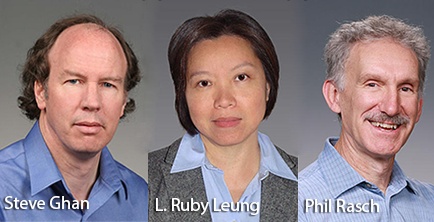Researchers joining project to build next-generation Earth climate model
06 Oct 2014
Eight national laboratories, including Pacific Northwest National Laboratory, are combining forces with the National Center for Atmospheric Research, four academic institutions and one private-sector company, to start work on the most complete climate and Earth system model yet.
High performance computing will be used for the project to address challenging and demanding climate change issues. Other participating national laboratories include Argonne, Brookhaven, Lawrence Berkeley, Lawrence Livermore, Los Alamos, Oak Ridge and Sandia.
The project, called Accelerated Climate Modeling for Energy, or ACME, is designed to accelerate the development and application of fully coupled, state-of-the-science Earth system models for scientific and energy applications. The plan is to exploit advanced software and new High Performance Computing machines as they become available.
The initial focus will be on three climate change science drivers and corresponding questions to be answered during the project's initial phase:
- Water Cycle: How do the hydrological cycle and water resources interact with the climate system on local to global scales? How will more realistic portrayals of features important to the water cycle (resolution, clouds, aerosols, snowpack, river routing, land use) affect river flow and associated freshwater supplies at the watershed scale?
- Biogeochemistry: How do biogeochemical cycles interact with global climate change? How do carbon, nitrogen and phosphorus cycles regulate climate system feedbacks, and how sensitive are these feedbacks to model structural uncertainty?
- Cryosphere Systems: How do rapid changes in cryospheric systems, or areas of the Earth where water exists as ice or snow, interact with the climate system? Could a dynamical instability in the Antarctic ice sheet be triggered within the next 40 years?
 | |
| PNNL scientists Phil Rasch, L. Ruby Leung, and Steve Ghan are part of the ACME leadership team and will provide expertise and leadership in key model process and Earth systems. |
"We are attempting to develop a model that is capable of exploring the three science problems using the best possible technology and treatment of physical processes at very high resolution," said Dr. Philip Rasch, PNNL chief scientist for climate science, member of the ACME council, and co-lead of the atmospheric model development task.
"The more comprehensive formulations and high resolution make the global model calculations prohibitively expensive using today's model frameworks and computers. Development of the new model requires a significant reframing of process representations and advanced computational methods directed towards the next generation of computers. Our goal is to perform a staged series of calculations that make progress on the project's grand challenge questions, exploiting today's computer architectures while we prepare for the next generation of machines."
To address the water cycle, the Project Plan hypothesised that: 1) changes in river flow over the last 40 years have been dominated primarily by land management, water management and climate change associated with aerosol forcing; 2) during the next 40 years, greenhouse gas (GHG) emissions in a business as usual scenario may drive changes to river flow.
"A goal of ACME is to simulate the changes in the hydrological cycle, with a specific focus on precipitation and surface water in orographically complex regions such as the western United States and the headwaters of the Amazon," the report states.
To address biogeochemistry, ACME researchers will examine how more complete treatments of nutrient cycles affect carbon-climate system feedbacks, with a focus on tropical systems; and investigate the influence of alternative model structures for below-ground reaction networks on global-scale biogeochemistry-climate feedbacks.
For cyrosphere, the team will examine the near-term risks of initiating the dynamic instability and onset of the collapse of the Antarctic Ice Sheet due to rapid melting by warming waters adjacent to the ice sheet grounding lines.
"Just evaluating, testing and tuning the model in preparation for the science questions is a huge computational task," Rasch said. "We are putting significant effort into developing more efficient ways to perform these tasks so we can afford to verify that the model solutions have reasonable fidelity compared to observed climate features, prior to launching the simulations needed to explore the science questions."
The experiment would be the first fully coupled global simulation to include dynamic ice shelf-ocean interactions for addressing the potential instability associated with grounding line dynamics in marine ice sheets around Antarctica.
Other PNNL researchers involved in the program are atmospheric scientists Dr. L. Ruby Leung (ACME leadership team and subtask coordinator of activities related to the representation of watersheds), and Dr. Steven Ghan (ACME leadership team and subtask coordinator for the representation of small scale elevation variations in global models). More than a dozen other scientists and engineers at PNNL will participate in developing, testing, evaluating and using the model to address the science questions mentioned above.
Initial funding for the effort has been provided by the US Department of Energy Office of Science.













.jpg)






.jpg)









